Small Modular Reactors (SMRs): The Nuclear Powerhouse Driving AI's Explosive Energy Demand
Executive Summary
TradingKey -Small modular reactors (SMRs) are compact, factory-built nuclear reactors designed to deliver clean, reliable energy to meet the surging demands of AI data centers, which the U.S. grid—36% oil, 36% gas, and inconsistent renewables—struggles to support. With a projected $7 billion market by 2030, SMRs face regulatory and supply chain challenges but are advancing through streamlined approvals and global development. NuScale Power, leveraging proven technology and government-backed funding, appeals to risk-averse investors who value stability and predictable progress, despite ongoing regulatory hurdles. Oklo, with its innovative but riskier microreactors, attracts risk-seeking investors betting on its disruptive, flexible design, though it faces significant regulatory and engineering uncertainties. Success for both hinges on overcoming these obstacles to drive AI-powered growth and global decarbonization.
Industry Overview
Remember when OpenAI and Nvidia announced a strategic partnership to deploy 10 GW of GPU systems, backed by up to $100 billion, to power the next generation of AI data centers? It’s a staggering leap for computing power, yet the data shows U.S. still gets 36% of its energy from oil, 36% from gas, 9% from coal, and 10% from nuclear. We’re essentially bolting an insatiable AI engine onto a grid built around aging fossil plants and unpredictable wind and solar.
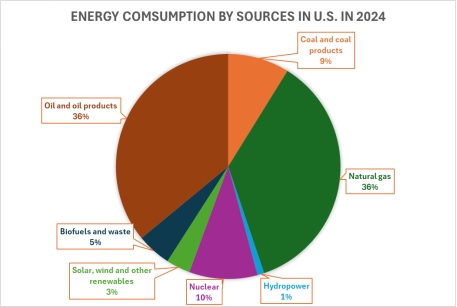
Source: IEA, TradingKey
That mismatch makes small modular reactors (SMRs) hard to ignore. These factory-built modules can be transported and assembled quickly, run 24/7 without emissions, and complement renewables to keep lights on when the wind dies down or the sun sets. Current market expects SMRs sector to reach $7 billion by 2030, but with AI data centers demanding round-the-clock power, that number feels wildly conservative. With regulatory bottlenecks now easing and factory production ramping up, SMRs could become the foundation for the future of digital power, transforming a niche sector into an essential engine for global AI-driven growth.
Introduction to Small Modular Reactors
Small modular reactors are transforming the landscape of nuclear power. Instead of the sprawling, multi-gigawatt plants of the last century, SMRs offer compact nuclear modules, each producing up to 300 Mwe. They are factory-built and shipped for on-site assembly. This modular approach not only streamlines construction and reduces required staffing, but it allows utilities and innovators to add capacity incrementally, matching demand and minimizing up-front risk.
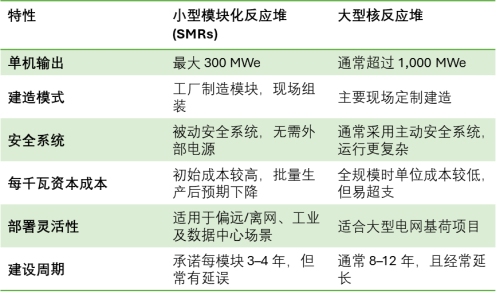
Source: NEA, TradingKey
The SMR journey unfolds in four distinct phases: design certification, site licensing, modular factory construction, and on-site assembly and commissioning:
Ÿ Concept & Design Certification: Vendors submit a Design Certification Application (DCA) to the U.S. Nuclear Regulatory Commission under 10 CFR Part 52, documenting safety analyses, system descriptions, and test data. Successful rulemaking yields a certified standard design, freeing future applicants from re-evaluating core safety features.
Ÿ Site Licensing & Permitting: Applicants file an Early Site Permit (ESP) or a Combined License (COL) under 10 CFR Part 52, which integrates construction and operating authorizations. COL applications include Environmental Impact Statements (EIS), seismic and hydrological studies, emergency-planning zone plans, and security assessments; NRC approval allows site clearing and construction to begin.
Ÿ Manufacturing & Modular Construction: Once site and design approvals are in hand, reactor modules: pressure vessels, steam generators, and control systems, are fabricated in factory settings under stringent quality assurance programs. This modular approach ensures repeatability, accelerates production, and minimizes weather-related delays.
Ÿ Assembly, Commissioning & Operation: Modules are transported to the site, assembled like puzzle pieces, and connected to balance-of-plant systems. Licensees then complete Inspections, Tests, Analyses, and Acceptance Criteria (ITAAC) stipulated in the COL before fuel loading, initial criticality tests, and commercial operation under NRC oversight.
The chart from NEA illustrates why SMRs can bridge the cost gap between small and large reactors: while large reactors benefit from economies of scale, SMRs start at a higher cost point, but they climb their own learning curve by shifting work from the field into factories, snapping together standardized modules like Lego bricks.
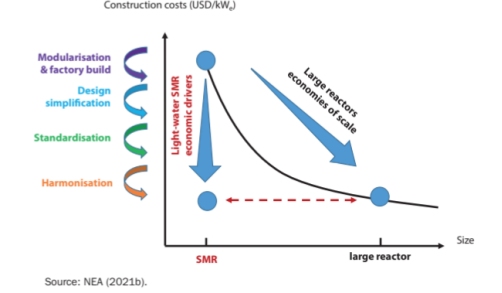
Source: NEA
By simplifying designs, using repeatable components, harmonizing safety reviews across multiple jurisdictions, and mass-producing modules under controlled conditions, SMRs steadily ratchet down per-unit capital costs. As serial production and regulatory alignment mature, the SMR cost trajectory converges toward that of large reactors, effectively bridging the gap between small-scale agility and large-scale economics.
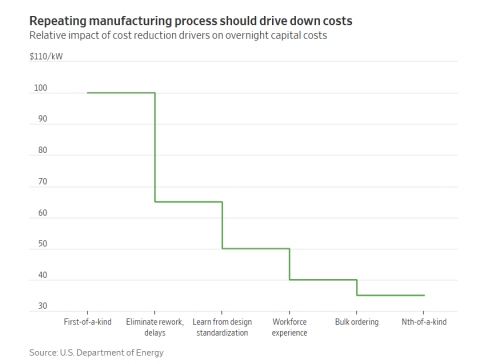
Source: U.S. Department of Energy
Global progress also proves this momentum. According to the World Nuclear Association’s SMR Global Tracker, 127 distinct SMR designs have been proposed worldwide, of which 74 are in active development and seven are operating or under construction. U.S. leads with multiple programs:
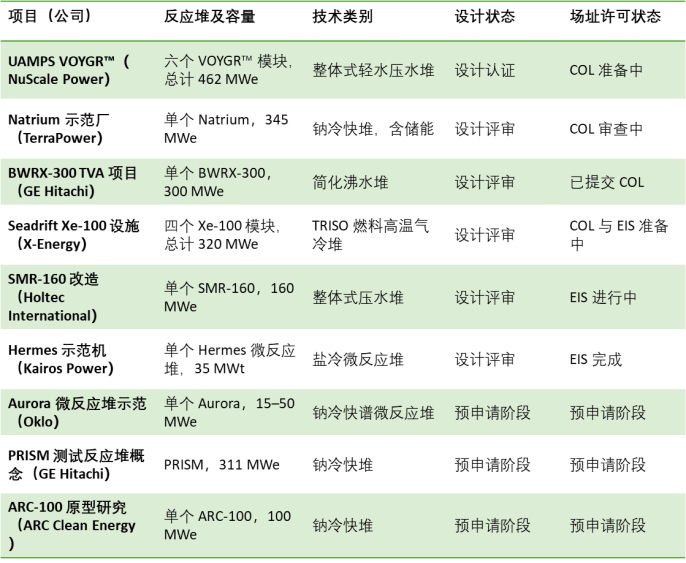
Source: NuScale, Reuters, Nuclear Business Platform, Energy For Growth, NEA, NRC, World Nuclear Association, TradingKey
Countries such as China, Russia, Argentina, and the United Kingdom have parallel efforts. Together, these initiatives represent a global shift towards modular nuclear solutions capable of supplying reliable, low-carbon baseload and flexible power for emerging applications, from off-grid mining camps to AI-optimized data centers.
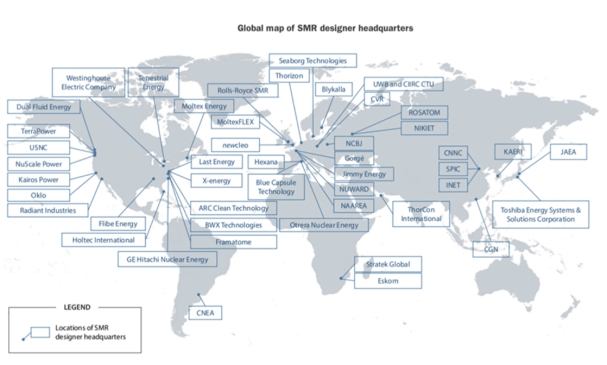
Source: NEA
Regulatory & Industry Challenges
Regulatory and industry challenges remain substantial for SMRs. Licensing is a slow, multi-step process that requires both generic design approval and site-specific permits, leading to extended timelines and compounding project risk. Even for NuScale’s certified designs, additional regulatory hurdles delay construction starting until at least 2026.
International projects have demonstrated that modular construction alone does not guarantee speed, with factory bottlenecks, supplier shortages, and real-world build delays repeatedly pushing back original schedules. In the U.S., a lack of local suppliers for advanced nuclear fuels, escalating costs, and an aging workforce further amplify these risks, while ownership and public acceptance hurdles remain critical. Even with government guarantees, most technical, supply-chain, and regulatory uncertainties continue to shape the pace and feasibility of deployment.
Two Contrasting SMR Investment Narratives
NuScale Power (SMR) and Oklo (OKLO) are the only pure-play, publicly traded SMR developers in the U.S., but their market journeys in 2025 have diverged sharply.
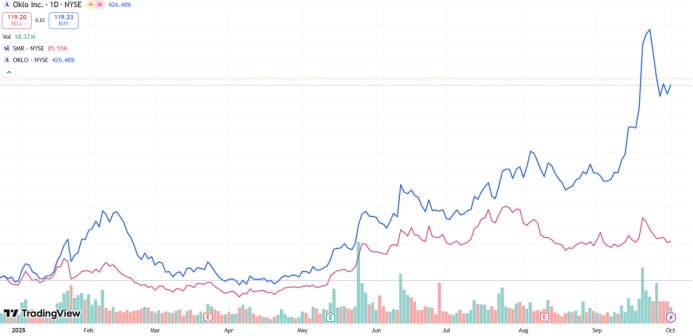
Source: TradingView
NuScale shares spiked by more than 120% in early 2025 on the back of presidential support and renewed policy momentum, reaching highs near $54. As licensing bottlenecks and DOE funding delays reemerged, however, the stock lost about a third of its gains, settling at $36 by late September, still more than double its level at the start of the year but well off the peak.
Oklo, meanwhile, staged a relentless run from $25 post-SPAC to $115 by September, a gain of over 400%, powered entirely by market enthusiasm and inflows, despite having no certified design or site license.
This stark split reflects a deeper dynamic: NuScale’s price is tightly linked to measurable progress and regulatory de-risking, while Oklo is trading almost wholly on narrative and the promise of disruptive first-mover status in flexible microreactors.
Technology Comparison & Capacity Flexibility
NuScale’s technology centers on the NuScale Power Module™ (NPM)—an independent, NRC-certified light water reactor, delivering a fixed 77 MWe per module. NPMs are factory-built, standardized, and proven, with each module operating autonomously and refueled every 18–21 months. The design leverages decades of pressurized water reactor (PWR) reliability and allows plant owners to build facilities in increments of 4, 6, or 12 NPMs.
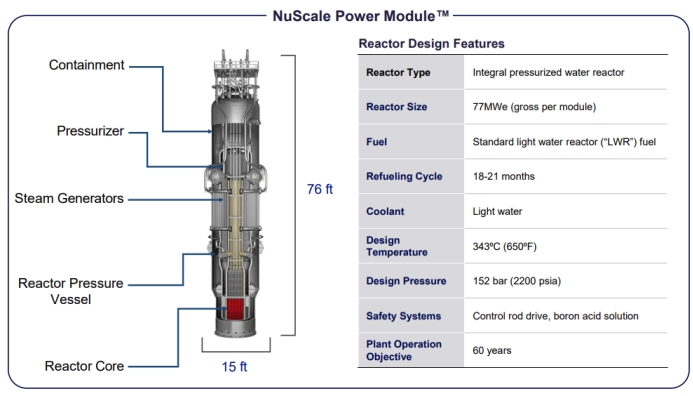
Source: NuScale
By contrast, Oklo’s Aurora microreactor is a flexible sodium-cooled fast reactor that can continuously adjust output between 15 MW and 75 MW on a single, certified platform without fresh regulatory filings or factory changes. Aurora’s core can run a full decade between refueling, consumes transuranic waste, and reaches around 45% thermal efficiency, notably higher than NPM’s roughly 33%. This flexibility comes at the cost of more bespoke engineering, specialized fuel handling, and added regulatory challenges, given its fast spectrum design and liquid sodium cooling.
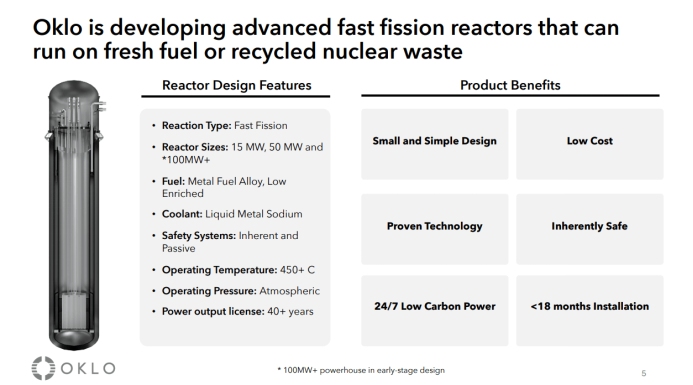
Source: Oklo
In short, NuScale’s NPM offers the certainty, safety, and modular standardization of mature PWR technology, with predictable first-unit costs and lower regulatory risk. Oklo’s Aurora, in pursuit of efficiency and true design flexibility, faces steeper licensing and engineering barriers, but the potential payoff is considerable for those willing to embrace added risk.
Deployment Strategy & Partner Ecosystems
NuScale has locked in its path to 2029 operation with formal, capital-backed agreements, roughly $600 million in DOE cost-share awards, and firm power-purchase contracts with UAMPS, TVA, RoPower, and ENTRA1. NuScale appeals to risk-averse institutional capital through formal cost-share grants and utility contracts, ensuring that each licensing milestone corresponds to committed off-take and funding.
Oklo, still in NRC pre-application with no site license, has instead built a narrative-driven ecosystem of non-binding MOUs from the U.S. Department of Defense to Diamondback Energy, KHNP, and ABB, and tapped a Silicon Valley syndicate (Hydrazine Capital with Peter Thiel, Dustin Moskovitz, Ron Conway, Kevin Efrusy, Tim Draper) despite no DOE awards or licensed reactors.
Financial Profile & Financing Status
With no commercial revenues, key financial metrics emphasize cash runway and valuation multiples. NuScale’s cash position, built up from multiple equity raises and cost-share awards, supports about 4.4 years of runway at its current burn, enough to reach key regulatory and commercialization milestones, but likely needing further capital to scale.
Oklo, buoyed by a $683 million balance and a lower current burn rate, holds an even longer runway, with $306 million of that total coming directly from its SPAC merger. While this provides strong financial flexibility for early-stage work, costs will inevitably accelerate as Oklo moves from concept to construction.
Metric | NuScale (SMR) | Oklo (OKLO) |
Share Price (Oct. 1st, 2025) | $36.61 | $115.93 |
Market Cap | $10.9B | $17.1B |
Cash & Equivalents (As of June 2025) | $490M | $683M |
Cash Burn Rate (Annualized) | $56M × 2 = $112M | $30.7M × 2 = $61.4M |
Runway (Cash/Burn, years) | 4.4× | 11.1× |
P/B | ~10× | ~24× |
Source: NuScale, Oklo, TradingKey
Risk Factors
· Prolonged, uncertain regulatory approval timelines create major execution and financing risk.
· Supply chain constraints for key components and enriched uranium can delay construction and inflate costs.
· Neither company has yet secured firm commercial orders, so they face cash burns without revenue for years.
· Local opposition and public perceptions about nuclear safety and waste can halt or slow new projects.
· Government guarantees can facilitate financing but shift financial risk from developers to taxpayers, leaving core technical and schedule risks unresolved.
Conclusion
The SMR sector is entering a defining phase, where progress depends on aligning regulatory reform, supply chain readiness, and new financing models to meet surging demand from industries like AI data centers and to drive global decarbonization.
Oklo’s appeal is strongest among investors willing to embrace early-stage design and regulatory risks for the chance to be first movers in the advanced microreactor segment. In contrast, NuScale’s steady progress, public funding, and focus on regulatory compliance continue to attract more risk-averse investors seeking validated technology, strong government partnerships, and long-term utility contracts. The divergent approaches highlight that, while enthusiasm and capital have returned to advanced nuclear, long-term winners will be determined by who can convert vision into licensed projects and dependable revenue fastest in a rapidly evolving energy landscape.



